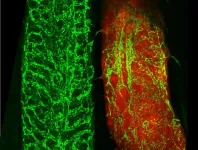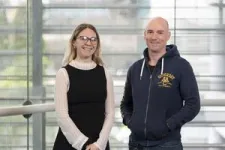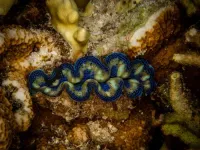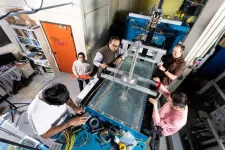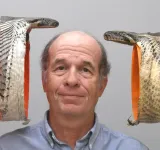(Press-News.org)
A landmark study led by WEHI and La Trobe University has found a potential new diagnostic marker that could be used to better detect the level of tissue damage in our bodies.
Extracellular vesicles (EVs) are small ‘delivery trucks’ released by our cells that deliver important materials to other cells to aid cellular communication. This study revealed, for the first time, a link between levels of EVs in the blood and tissue damage caused by diseases such as leukaemia.
Researchers hope to leverage the critical new insight to develop a blood test to monitor cancer patients with tissue damage, which could, in future, enhance treatment strategies for blood cancers and other diseases.
View and embed the video: https://youtu.be/bgazVHlHfQE
At a glance
Landmark study shows, for the first time, a link between extracellular vesicles (EVs) and blood vessel damage caused by blood cancers in animal models.
The world-first study observed EVs inside the bone marrow of live mice for the first time, and found that monitoring the levels of EVs in the blood could provide direct insight into the level of tissue damage – critical information that may inform ways to better detect and treat diseases.
The findings are being leveraged to determine whether EVs can be used as a biomarker in patients with acute myeloid leukemia (AML) to help determine the extent of disease and whether it has spread to nearby organs.
Extracellular vesicles (EVs) are like small delivery trucks that are dispatched by our cells to distribute important materials like proteins, fats and genetic information to other cells.
This delivery system helps cells communicate with each other, especially when they are under stress or dying.
Research into how EVs form and their link to disease progression is challenging because of their small size, with most studies restricted to a ‘cells-in-a-dish’ approach.
In an unprecedented study, researchers were able to overcome this significant barrier by imaging live EVs inside the bone marrow of mice.
First author and WEHI cell biologist, Dr Georgia Atkin-Smith, said the team used high-resolution microscopy that can see directly inside the bone marrow of live organisms to capture the formation of EVs from blood vessels.
“No other study in the world has been able to achieve this so it’s a huge win for Australia’s scientific community,” Dr Atkin-Smith said.
“In this study, we’ve shown that the development of leukemia can degrade healthy blood vessels in the bone marrow. Mice with extensive blood vessel damage in their bone marrow had elevated levels of EVs in their blood, while healthy mice did not.
“This revealed – for the first time – that there is a link between EVs in the blood and tissue damage during cancer.
The potential link between EVs and blood vessel damage was first hypothesised in 2018 by senior author and WEHI Laboratory Head, Associate Professor Edwin Hawkins, who is an expert in ‘in vivo imaging’ – techniques that allow researchers to see inside living organisms.
“To have seen how the process of EV formation occurs with our own eyes after four years of research was an incredible moment,” Dr Atkin-Smith said.
“Pictures tell a thousand words, and these ones have significantly advanced our understanding into EVs by showing how they form under both healthy settings and during disease.
“This has not only developed a new framework to study the formation of EVs in model organisms, but could inform new diagnostic tools to monitor the level of tissue damage observed during disease through a simple blood test. It’s an incredibly exciting advancement.”
EV biology: From fish to mice to humans
The study involved a significant collaboration with Professor Ivan Poon, Director of the La Trobe Research Centre for Extracellular Vesicles (RCEV) – the largest group of EV researchers in the Southern Hemisphere.
La Trobe PhD candidate and second author, Jascinta Santavanond, has been developing world-class imaging techniques to study cell death and zebrafish biology.
“This study is a testament to what can be achieved through scientific collaboration,” she said.
“By working together, we have validated our results in fish, mice and human samples, truly highlighting the impact of the research.”
The WEHI research team is now assessing whether EVs can be used as a biomarker in acute myeloid leukemia (AML) patients, through a collaboration with the Peter MacCallum Cancer Centre (Peter Mac). They hope to develop new tools and techniques that would allow clinicians to determine the impact of disease on healthy tissue, and assess the disease progression by analysing patient samples.
The study, published in Nature Communications, also involved collaborations with the University of Melbourne, The Florey, Olivia Newton-John Cancer Research Institute, Peter Mac and Monash University.
The research was supported by the National Health and Medical Research Council, Australian Research Council, CASS Foundation, Jack Brockhoff Foundation, L’Oreal UNESCO For Women in Science, Victorian Cancer Agency, a Sir Clive McPherson Family Fellowship and a Rae Foundation grant.
END
Public and community engagement in decision making is key to enhancing urban living conditions and the environment in China, a new study says.
There has been significant progress through legislation to promote the role of citizens in environment and nature-based solutions (NBS), but progress in involving the public in projects has been limited, the research shows.
However, there has been some work in gathering public opinion and involving them in the project design and decision-making of government-led and large NBS projects.
Researchers found smaller local NBS projects tend to see higher levels of public participation, ...
Bagheri To Leverage Recycled Polyurethane Foam For Real-World Applications Shaghayegh Bagheri, Assistant Professor, Mechanical Engineering, College of Engineering and Computing (CEC), received funding for the project: “Leveraging Recycled Polyurethane Foam for Real-world Applications.”
Bagheri ...
Image
Research led by the University of Michigan has pored over more than two decades' worth of data from NASA's Chandra X-Ray Observatory to show there's new knotty science to discover around black holes.
In particular, the study looks at the high-energy jet of particles being blasted across space by the supermassive black hole at the center of the galaxy Centaurus A.
Jets are visible to different types of telescopes, including those that detect radio waves and others that collect X-rays. Since Chandra's 1999 launch, many astronomers have been particularly interested ...
An engineer with decades of experience in industry and higher education will serve as the CEO of the Upstate New York Energy Storage Engine led by Binghamton University.
Meera Sampath, who holds a doctorate in electrical engineering from the University of Michigan, Ann Arbor, previously was the associate dean of research in Binghamton’s Thomas J. Watson College of Engineering and Applied Science.
Sampath spent the first 20 years of her career with Xerox Corp., including time as the vice president for innovation and business transformation at Xerox Services and as founding director of the Xerox Research Center India. From there, she ...
(Philadelphia, PA) – A team at the Lewis Katz School of Medicine at Temple University, part of Temple Health, has been awarded nearly $1 million by the Patient-Centered Outcomes Research Institute (PCORI) to help improve antibiotic prescribing for children with acute respiratory tract infections.
“Many children with symptoms of upper respiratory tract illness who are taken to see a pediatrician end up being prescribed antibiotics, even though they aren’t always needed,” explained Janet Lee, MD, Associate Professor of Pediatrics, Lewis Katz School of Medicine. Dr. Lee and Claire Raab, MD, President ...
CRISPR-Cas9 has long been likened to a kind of genetic scissors, thanks to its ability to snip out any desired section of DNA with elegant precision.
But it turns out that CRISPR systems have more than one strategy in their toolkit. A mechanism originally discovered in bacteria, where it has operated as an adaptive immune system for eons, CRISPR is naturally deployed by certain singled-cell organisms to protect themselves against viruses (called phages) and other foreign genetic fragments. Now, researchers at Rockefeller’s Laboratory ...
The giant clam, known for its colorful cape-like mantle, wavy shell and astonishing size, is in danger of going extinct after its population plunged by more than 80% over the last century, according to a new assessment by a University of Colorado Boulder biologist and collaborators.
The assessment, led by Ruiqi Li, a postdoctoral researcher at the CU Museum of Natural History, prompted the International Union for Conservation of Nature (IUCN) today to update the conservation status of this animal from “vulnerable” to ...
The U.S. Department of Energy (DOE) recently granted the Atlantic Marine Energy Center (AMEC) $12 million to expand research and development in marine energy initiatives. AMEC comprises four universities including the University of New Hampshire, Stony Brook University, the Coastal Studies Institute, and Lehigh University.
In total, DOE’s Water Power Technologies Office invested more than $41 million in this latest round of funding using the Bipartisan Infrastructure Law (BIL) to four university-led National Marine Energy Centers located across the country. The centers will use the funds to support research, infrastructure improvements, strategy, administration, outreach, ...
Burmese pythons can consume prey even larger than scientists realized, according to a new study.
That means more animals are on the menu across southern Florida, where the nonnative, invasive snakes have decimated populations of foxes, bobcats, raccoons and other animals.
Pythons swallow deer, alligators and other prey whole. What they eat is limited in part by how big an animal they can wrap their flexible, stretchy jaws around. Researchers call this the snake’s gape.
University of Cincinnati Professor Bruce Jayne said measurements of snakes captured in and around Everglades National Park show that the biggest pythons have an even bigger gape than mathematical ...
Image
Almost 14 billion years ago, at the very beginning of the Big Bang, a mysterious energy drove an exponential expansion of the infant universe and produced all known matter, according to the prevailing inflationary universe theory.
That ancient energy shared key features of the current universe's dark energy, which is the largest mystery of our time by at least one objective standard: It makes up the majority—roughly 70%—of the universe, but scientists ...
